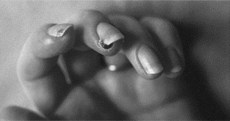149 Scleroderma
Salient features
Examination
• Thickening and tightening of the skin over fingers, sclerodactyly (finger pulp atrophy) (Fig. 149.1), beaking of nails (pseudoclubbing), atrophic nails, telangiectasia (nailfold capillaries) (Fig. 149.2)
• Raynaud’s phenomenon (see Fig. 161.1)
• Subcutaneous calcification (fingers, elbows and extensor aspect of the forearms)
Questions
What other organ systems are involved?
Skin. Raynaud’s phenomenon, localized morphea, local or generalized oedema, hyperpigmentation, telangiectasia, subcutaneous calcification, ulceration, particularly at the fingertips. Ten-year survival rate is 71% with skin tightness limited to fingers but 21% with diffuse truncal skin involvement. Ilioprost, a prostacyclin analogue, helps to heal digital ulceration. Penicillamine improves the skin and prolongs survival in patients with early, rapidly progressive, systemic sclerosis.
Musculoskeletal system. Arthritis, myositis, myopathy, bone ischaemia with resorption of the phalanges.
GI tract. Dysphagia, reflux oesophagitis, large or small bowel obstruction.
Lung. Fibrosis, atelectasis, pulmonary hypertension; pneumonia.
Kidney. Glomerulonephritis, malignant hypertension (poorest prognosis with renal involvement). ACE inhibitors dramatically improve renal crisis.
Stay updated, free articles. Join our Telegram channel

Full access? Get Clinical Tree




